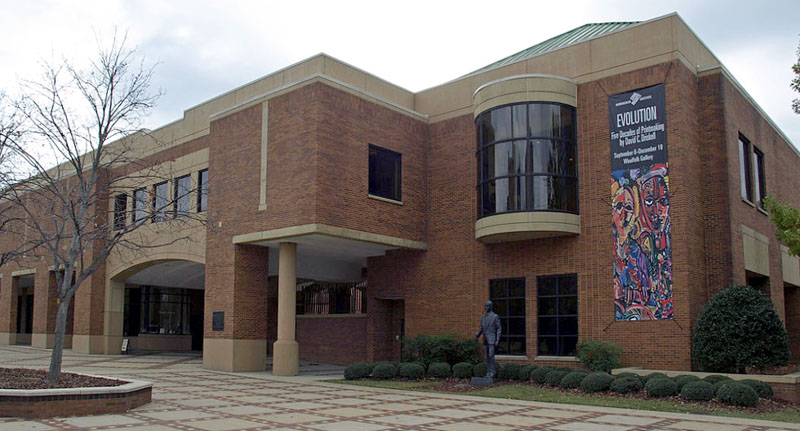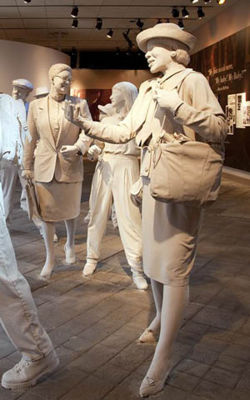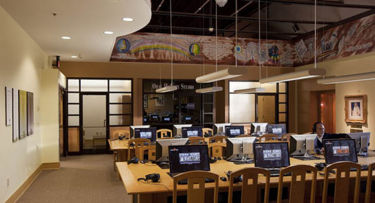Birmingham Civil Rights Institute
The Birmingham Civil Rights Institute (BCRI) is an interpretive museum, gallery and research center located adjacent to Kelly Ingram Park in Birmingham's Civil Rights district. Though operating as a private non-profit institution, the BCRI was created by the City of Birmingham. It opened on November 14, 1992. In 2008 the institute reported 168,370 visitors, making it the 9th most popular admission-charging attraction in the state.
The institute's mission reads "Inspired by our civil rights past, our mission is to encourage communication and reconciliation of human rights issues worldwide, and to serve as a depository for civil rights archives and documents." Since 2002 the BCRI has presented an annual "Fred L. Shuttlesworth Human Rights Award".
The President and CEO of the BCRI is DeJuana Thompson. Isaac Cooper is chair of the Birmingham Civil Rights Institute Board of Directors.
History
The concept of creating a civil rights museum for the city was given its first official consideration in a weekly news conference by then-mayor David Vann. A year later, the Birmingham City Council endorsed the recommendation. In 1979, newly-elected mayor Richard Arrington was authorized by the council to form a committee to pursue the project. Vann and UAB historian Horace Huntley were asked to co-chair the Civil Rights Museum Study Committee in 1981. The committee recommended proceeding with the creation of a board of directors and with property acquisition.
While the city began piecing together property, Arrington appointed Odessa Woolfolk and Frank Young to co-chair a new Civil Rights Institute Task Force. The new group drafted a mission statement and began working with architects and exhibit designers to plan a thematic program for the public museum. A proposed 1986 bond issue that included $24 million for the BCRI, a science museum and improvements to the Birmingham Museum of Art was defeated by voters.
Undaunted, the Civil Rights Institute Task Force approved exhibit plans created by the American History Workshop and a building design by New York architecture firm Bond Ryder James in 1987.
Meanwhile the City had consolidated plans for a Civil Rights District centered around Kelly Ingram Park. Mayor Arrington approved plans for renovating the park, creating a Jazz Hall of Fame in the Carver Theatre, establishing a site for the Civil Rights Institute, and landscaping public spaces around the 16th Street Baptist Church. Grover Mouton of New Orleans developed the schematic plans for the district while Grover Harrison Harrison landscape architects of Birmingham drew up the detailed design, which included a group of evocative sculptures by James Drake.
A proposed 1988 bond issue that would have raised $110 million, including $25 million for various museums, was also voted down. Nevertheless, on September 15 of that year, the 25th anniversary of the bombing of 16th Street Baptist Church, a sign announcing the "Future Site of the Birmingham Civil Rights Institute" was dedicated.
In 1990 the City Council created a 15-member Board of Directors to pursue the project with a fund-raising campaign. Odessa Woolfolk was appointed president and the new Board adopted the mission statement and exhibit program recommended by the previous Task Force, but hired Boston architect Joseph Wetzel to create a new building design. Revenue bonds issued in 1991 by the Historical Preservation Authority of Birmingham provided initial funding for the redevelopment of the Civil Rights District and construction of the museum. As the facility neared completion, the City entered into an operating agreement with the independent Board to manage the BCRI, Carver Theatre and Alabama Jazz Hall of Fame.
A statue of local Civil Rights leader Fred Shuttlesworth was unveiled in front of the building on Saturday, November 14, 1992. The facility was officially dedicated on Sunday by former Atlanta mayor and United States Ambassador to the United Nations Andrew Young. It opened to the public on Monday, November 16. Over 25,000 people visited the museum during its first week.
The Institute and related projects were honored in 1993 with an Honor Award from the National Trust for Historic Preservation.
In 2007 the Institute concluded a $6.3 million fund-raising campaign, "Expanding the Legacy", which was allocated toward refurbishment and renovation of the Institute's exhibit areas. Changes included the incorporation of additional artifacts, some loaned as part of a newly-forged Smithsonian Institution Affiliation.
In the 2010s the BCRI's board adopted a "Vision 2020" strategic plan which included goals of doubling the number of visitors to the institute, promoting the Birmingham Civil Rights National Monument, facilitating quality programs, and securing the health and national importance of the organization.
In late 2018 the BCRI's board voted to rescind the Fred L. Shuttlesworth Human Rights Award due to controversial stances held by the announced recipient, Angela Davis. Backlash for the decision led to three resignations from the board before another vote reinstated the award. In early 2019 the board announced that it would expand from 9 to 21 members. In March a newly-convened "Accountability Advisory Task Force" was put together by the city, facilitated by Denise Gilmore, then serving as Director of Cultural Preservation on Mayor Randall Woodfin's staff. The Task Force delivered an 11-page report on June 10, finding that the center's agreement with the city is not aligned with its mission and that it lacks the monetary and staffing resources necessary to succeed. A new operating agreement was proposed for discussion beginning in September.
The institute's revenues from visitors and events plummeted due to the 2020 Coronavirus pandemic. The Institute launched a $750,000 fund-raising drive. Regions Bank provided a $75,000 grant as part of that campaign. In March 2023 the Jefferson County Commission allocated $900,000 of its American Rescue Plan Act funds to support the institute's appointment of a full-time curator of exhibits.
Exhibits
The Birmingham Civil Rights Institute features a moving interpretive journey that tells the story of the Civil Rights Movement from the days of segregation, through the struggles of activists to the triumphs of the 1960s and the continuing struggle for human rights around the world.
A visit to the museum begins with the 12-minute film "Going Up to Birmingham", which places the new industrial city of Birmingham into the context of the post-war South. At the films conclusion, the screen opens, revealing the "Barriers Gallery" with 14 exhibitions showing the extent of segregation and racism in all walks of life in the first half of the 20th century.
The next exhibit, dubbed the "Confrontation Gallery" tells the story of the turmoil following the landmark Brown v. Board of Education decision which called for an end to segregation in the United States. Episodes of violent resistance to integration are detailed in through photographs and news reports from the era.
The "Movement Gallery" shows how the Civil Rights Movement was organized to pursue justice. Multi-media exhibits in this gallery include the "Bus Ride to Freedom" covering the Freedom Rides through the south; "Give us the Vote" documenting voting rights abuses; "Birmingham: The World is Watching" showing news footage from Birmingham and the cell door from behind which Martin Luther King, Jr penned the "Letter from Birmingham Jail" in 1963; and "The March", immersing the visitor in the march on Washington.
The emotional high of King's "I Have a Dream" speech is followed by the "Processional Gallery" with various life-size statues urging visitors along with them toward the dream of freedom, culminating in the "Milestones Gallery" with iron pedestals marking specific achievements of the Civil Rights Movement toward establishing equal rights.
The last gallery, dedicated to Human Rights, highlights struggles around the world while a video on the Universal Declaration of Human Rights is played.
Research center
In addition to presenting an interpretive journey through the Civil Rights story, the BCRI houses archives of primary documents and a library of materials on Civil Rights history. The Richard Arrington Jr Resource Gallery gives students access to multi-media materials through computer terminals. A highlight of the collection is the "Behind the Veil Oral History Project" which produced videotaped oral history interviews of participants in the movement. Many of these same resources have been made available over the internet in the BCRI's Online Resource Gallery.
The archives division of the Civil Rights Insitute houses records and documents for scholarly research on global civil and human rights issues. Special collections include archives from the Alabama Christian Movement for Human Rights, the Emancipation Association of Birmingham, the Concerned White Citizens of Alabama, A. H. Parker High School, various newspapers and periodicals, the Fred Shuttlesworth collection, the A. G. Gaston collection, NAACP and SCLC materials, numerous photographs, publicity materials and other artifacts and collections of correspondence.
Chief executives
- Lawrence Pijeaux, 1995–May 2014
- Priscilla Hancock Cooper (interim), May 2014–September 2015
- Andrea Taylor, September 2015–April 2020
- DeJuana Thompson (interim) March 2021–May 2022
- DeJuana Thompson, May 2022–
References
- Arrington, Richard (2008) There's Hope for the World: The Memoir of Birmingham, Alabama's First African-American Mayor Tuscaloosa: University of Alabama Press
- Rossman-Reich, Philip (June 17, 2008) "Civil Rights Institute plans major renovations." The Birmingham News
- Huebner, Michael (January 18, 2009) "Institute created through struggle, much like the story it preserves." The Birmingham News
- Williams, Roy L. (March 3, 2009) "Space & Rocket Center tops list of state attractions, tourism agency says." The Birmingham News
- Hanc, John (March 14, 2012) "Birmingham’s Civil Rights Institute Personalizes a Struggle" The New York Times
- Huebner, Michael (January 31, 2013) "Birmingham Civil Rights Institute's mission of diplomacy, education and human rights having a global impact." The Birmingham News
- Cooper, Priscilla Hancock (August 2018) "A City Embraces Its Past, Looks to the Future: A Perspective on the Evolution of the Birmingham Civil Rights Institute" The Public Historian, Vol. 40, No. 3, pp. 211–231
- Woolfolk, Odessa (October 2018) "BCRI History". BCRI.org - accessed August 13, 2020
- Johnson, Roy S. (January 27, 2019) "Civil Rights Institute CEO talks ‘lessons learned’ from Davis turmoil, meeting with protesters" The Birmingham News
- Beahm, Anna (March 20, 2019) "Birmingham Civil Rights Institute seeking to fill 21 seats on board of directors." The Birmingham News
- Johnson, Roy S. (September 1, 2019) "Johnson: The resurrection of BCRI A.D. (After Davis) begins." The Birmingham News
- Johnson, Roy S. (May 4, 2022) "BCRI removes ‘interim’ tag for president, CEO; institute raised $2.4 million, ‘We’re in a good place’." The Birmingham News
External links
- Birmingham Civil Rights Institute website
- BCRI Collections Guide (PDF)


